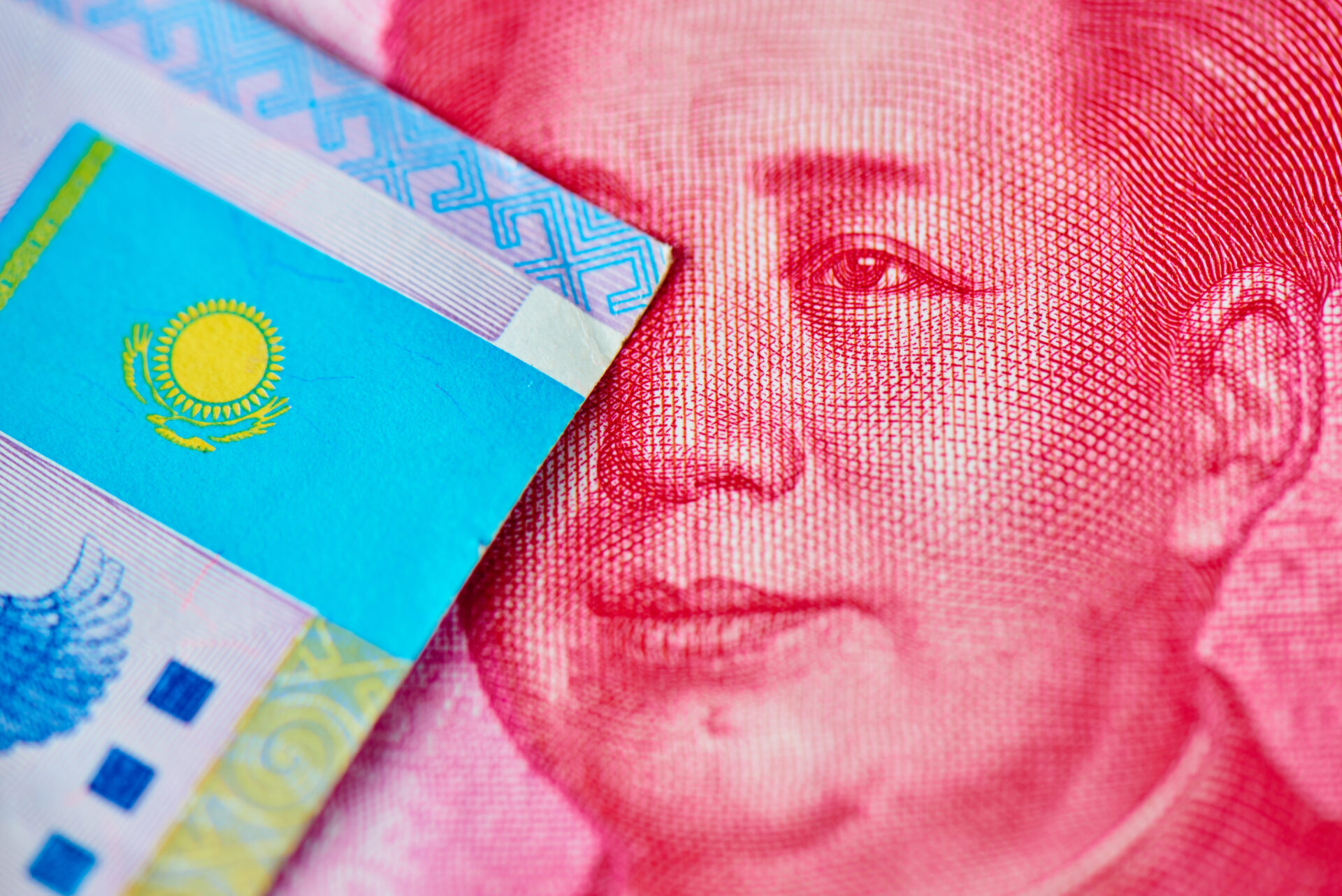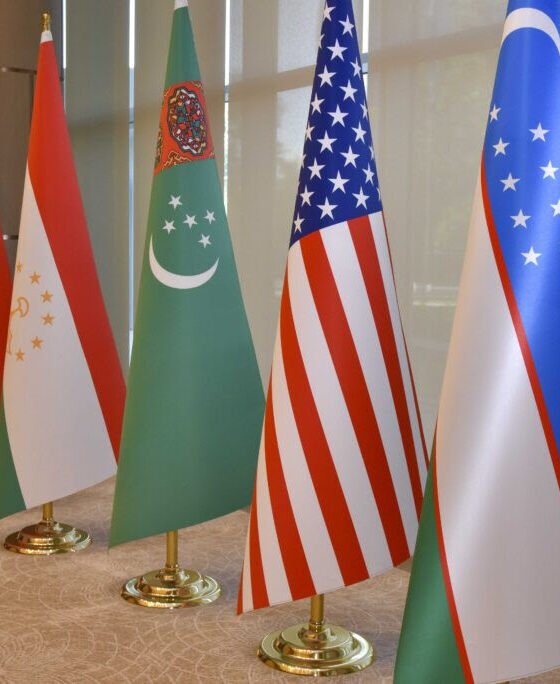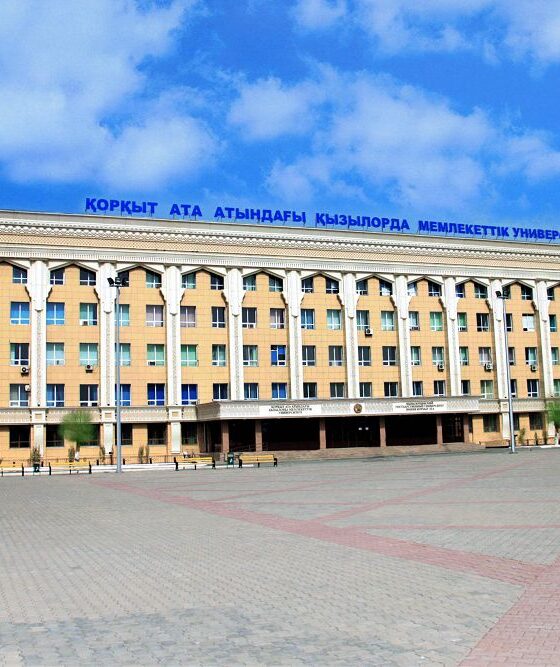
By Dr. Kemel Toktomushev
Dr. Kemel Toktomushev is a Senior Research Fellow with University of Central Asia’s (UCA) Institute of Public Policy and Administration and an Assistant Professor of Political Science with UCA’s School of Arts and Sciences. His primary research interests focus on economics of development and good governance in emerging economies. Toktomushev is the author of Kyrgyzstan – Regime Security and Foreign Policy published by Routledge. Toktomushev holds a PhD in Politics from the University of Exeter and a Master of Science in International Relations from the London School of Economics.
Over the past three decades, China has emerged as the key economic player in Central Asia, outpacing the region’s traditional partner, the Russian Federation. From financing the modernization of hydroelectric power stations and power transmission lines to the construction of roads, tunnels, and administrative buildings, China has made its presence in the region both visible and tangible. That said, China’s relations with the Central Asian states remain complex: while ruling elites welcome China’s economic engagement in the region, local communities have grown wary of China and sought to resist its outreach.
Accordingly, this paper will explore whether China’s diplomacy in its neighborhood may deepen existing fault lines and feed rapidly growing Sinophobia in the region. In particular, the paper will examine how China’s greater engagement in Central Asia might exacerbate the cleavages between autocratic ruling elites, on the one hand, and the ordinary population, the political opposition, and nativist actors, on the other. As the paper will expose, perceptions that China is contributing to social injustice, poor and corrupt governance, and economic hurdles can be exploited by various actors for violent mobilization of xenophobic sentiments against both Central Asian elites and Chinese entrepreneurs.
China in Central Asia: Building a “Community of Common Destiny?”
China’s stepped-up role in Central Asia should be viewed in the context of changes in China’s foreign policy. With the accession to power of Xi Jinping, China’s foreign policy entered a new phase. Xi called for China’s return to its past grandeur, both domestically and internationally. This “Chinese Dream of Great Rejuvenation” was presented as a vision that would change the global landscape and pave the way for a new Sinocentric order. Accordingly, the pursuit of the Chinese dream was set to become the linchpin of Xi’s tenure.
Unlike his predecessors, who had primarily been preoccupied with great power relations, Xi underlined the importance of Beijing’s relations with its neighbors. Thus, Xi’s idea of “the community of common destiny” emerged as an inextricable element of the “Chinese Dream of Great Rejuvenation.” The community of common destiny rejects a zero-sum approach to international relations and calls for political partnerships, inclusive development, multilateral security architecture, and inter-civilization exchanges.[1] According to Xi, through the promotion of the community of common destiny, China will create an environment conducive to the development both of China and of its neighbors.[2]
The unveiling of the Belt and Road Initiative (BRI) in 2013 was the first major signal that regional integration and neighborhood diplomacy had become China’s top priority in foreign policy. BRI advances a vector of Chinese development that is focused on regional integration and peripheral diplomacy. Although the BRI’s geographical boundaries now extend far beyond these limits, it was initially focused on China’s immediate neighbors, particularly those to China’s West in Central Asia. This may explain why BRI was first unveiled in Central Asia. Speaking at Nazarbayev University in Kazakhstan, Xi proposed to utilize this “golden opportunity” to create a New Silk Road Economic Belt to accelerate connections between China and the Central Asian states.[3] He also cited the old Chinese proverb that “a near neighbor is better than a distant cousin”[4] and highlighted the longstanding interchanges between China and its neighbors. Hereafter, Xi would continuously stress the importance of building “one family of harmonious co-existence,” while Beijing’s narratives would reiterate the prospects and benefits of good-neighborliness.
Indeed, although Russia at least nominally retains its title as the region’s traditional partner, as it engages with the states of Central Asia both bilaterally and multilaterally through the Eurasian Economic Union (EEU) and the Collective Security Treaty Organization, China’s presence in Central Asia is becoming more evident. China has become the main export destination for the region’s commodities and goods; it also provides a significant share of Central Asia’s total imports. Officially, Chinese trade with the Central Asian states ballooned from $1 billion in the early 2000s to nearly $50 billion in 2013 before falling somewhat to $41 billion in 2018,[5] but high volumes of informal trade mean that these figures may vastly underrepresent total trade flows. Concomitantly, China became the region’s primary source of development finance and its largest source of foreign direct investment (FDI), mostly through China’s state-owned enterprises. Between 2006 and 2017, more than 25% of total FDI in Kyrgyzstan and Tajikistan came from China, while Kazakhstan has become the largest recipient of Chinese investment in Central Asia, with $16-21 billion of investments, according to various estimates.[6] Moreover, over the past decade, China has played a major role in large public infrastructure projects across Central Asia.
That said, China’s growing role in Central Asia has exposed diverging responses between elites and the public. It appears that the postulate of “warm politics, cold public” (“zheng re, min leng”) best reflects the attitude of ordinary Central Asians toward China.[7] This Chinese expression underlines that China may have warm relations with governments and ruling elites, yet relations with the people remain cool or even hostile.[8]
Even the barest analysis of the discourses of Central Asian leaders reveals that they uniformly welcome Chinese capital to Central Asia and openly acknowledge Beijing’s growing role in the region. Official discourses downplay the history of confrontation and enmity with China, referring instead to the heyday of the Ancient Silk Road. Despite complaints that the BRI was the functional equivalent of a Chinese Marshall Plan, the promises of the BRI aligned well with national development agendas. Central Asian leaders have not tried to play China off against any other country or regional hegemon and instead proposed to align BRI with the Russian regional integrationist initiative, EEU.
Whereas the region’s leaders have welcomed China’s economic engagement and support for regional development, grassroots resistance to Chinese outreach has served to complicate Sino-Central Asian rapprochement at the elite level. According to the Central Asia Protest Tracker compiled by the Oxus Society for Central Asian Affairs, there have been 97 anti-China protests in Kyrgyzstan and Kazakhstan alone in the past three years.[9] Soviet clichés that cast China as an enemy have not evaporated; local communities, including younger generations, continue to view China’s activities in the region through the lenses of Chinese imperialism and expansionism. The concerns of Central Asian communities range from debt traps and the repercussions of Chinese investments for structural governance to the impact of Chinese projects on the natural environment, people’s livelihoods, and the socio-political stability of the region.
Unlike political and economic elites, who may benefit directly from China’s engagement in Central Asia, the general populace does not seem to buy Beijing’s discourses of peace, inclusiveness, and mutual benefit. Even the prospect that BRI might transform the infrastructure-impoverished states of Central Asia has not served to mitigate recurring protests against Chinese investors across the region. For instance, according to Central Asia Barometer and Integration Barometer surveys, average opinion of China is 58 out of 100 in Kazakhstan, 54 out of 100 in Kyrgyzstan, and 68 out of 100 in Uzbekistan.[10] Only 15% of respondents in Kazakhstan, 10% in Kyrgyzstan, and 20% in Tajikistan indicated that they view China as friendly and reliably helpful. In contrast, Russia is viewed positively by 81%, 87%, and 78% of respondents in Kazakhstan, Kyrgyzstan, and Tajikistan, respectively.[11] A study conducted by the Center for Insights in Survey Research in Kyrgyzstan further reveals that Kyrgyz views of China are polarized: 35% of respondents believe that China poses the greatest economic threat to Kyrgyzstan, while 32% believe China is the country’s most important economic partner.[12]
The impact of COVID-19 on anti-Chinese sentiments has yet to be determined. Beijing was quick to provide testing kits, protective gear, and medical expertise to the Central Asian states. However, the Chinese gesture of good will was lost in a stream of negative information as Central Asian governments failed to deal with the outbreak and the death toll skyrocketed. It is already evident that the Central Asian economies will face severe recessions and may not recover to their pre-crisis growth rates any time soon.
Such resistance to Chinese investment contrasts starkly with the narrative of the Chinese dream. In this regard, it becomes imperative to understand what China’s rise means for the Central Asian states, since they are the ones who will be the first exposed to the direct and ancillary impacts of China’s “Great Rejuvenation” initiatives.[13]
China-Central Asia Fault Lines
The dynamic region of Central Asia is infamous for its autocratic regimes, clan-based politics, rampant corruption, structural economic problems, and socio-political instability. The legacies of both the Soviet Union and the bursts of Western engagement after its demise fostered an environment in which authoritarian governance easily became hegemonic.[14] Although it is as yet uncertain where China’s greater engagement in the region will lead, there are real risks that by exacerbating the problems of political accountability and economic governance, China’s interventions in Central Asia will deepen existing cleavages between autocratic ruling elites, on the one hand, and the ordinary population, the political opposition, and nativist actors, on the other.
Rooted in its Five Principles of Peaceful Coexistence, Chinese narratives of China as an alternative actor that extends benevolent support to its neighbors without “strings attached” mesh well with the expectations of Central Asian elites. Unlike Western initiatives, Chinese projects do not require political and institutional reforms. It appears that all China requests from the Central Asian states in exchange for economic support is their loyalty; their commitment to fight terrorism, separatism, and extremism; and their adherence to the One China policy.[15] Yet such an approach is unlikely to foster the changes for which Central Asian communities have been yearning since the collapse of the Soviet Union.
In this graft-prone region, the unprecedented influx of funding has not necessarily translated into growth and prosperity. Not only are there uncertainties about the economic benefits and environmental impacts of these multi-million-dollar projects, but such projects can strengthen autocratic ruling regimes, which are not as gullible as they may seem. Indeed, there have already been a plethora of alarming signals. For example, in 2010 Tajikistan upgraded the 214-mile highway that connects its capital with Uzbekistan using a $296 million loan from China.[16] Soon thereafter, however, this highway was transformed into a toll road run by a company registered in the British Virgin Islands. This company, Innovative Road Solutions, received preferential treatment from the government and was exempt from paying more than a dozen taxes. The parliament of Tajikistan also scrapped the law that prohibited running a toll road where there were not free alternative routes available.[17] Although the company’s registration in a secretive tax haven prevents the tracing of the company’s real beneficiaries, it is apparent that powerful interest groups have captured the project for personal gain.
In neighboring Kyrgyzstan, there is an ongoing criminal case centered on allegations that high-ranking Kyrgyz officials lobbied for the Chinese company Tebian Electric Apparatus Stock Co. Ltd. (TBEA). TBEA won a US$386 million contract to modernize a power plant in Bishkek. The modernization was financed by a loan from the Export-Import Bank of China. Two years ago, two former Kyrgyz prime ministers, Sapar Isakov and Zhantoro Satybaldiyev, received lengthy prison terms on corruption charges for their involvement in the plant’s modernization.[18] Former president Almazbek Atambayev is also facing charges related to this case, having already received 11 years and 2 months in prison on corruption charges in a different case.[19] Such cases demonstrate that even high-profile investment projects can fall victim to the predatory encroachments of local elites.
More significantly, rent capture can stall democratic progress. Lucrative licit and semi-licit contracts not only enrich autocratic leaders and their entourages, but also help kleptocratic elites strengthen their regimes. Unaccounted resources can be used in a multitude of notorious ways, from funding pressure groups, criminal gangs, and fake opposition parties to strengthening secret services and law enforcement agencies. In some instances, the distribution of rents may emerge as a cause of fracture between different clans and power groupings, which can lead to inter-clan confrontations and political instability.
The most vivid example comes from the recent events in Kyrgyzstan. On October 5, 2020, the main square of Bishkek attracted large crowds of people who were aggrieved by the preliminary results of the parliamentary elections. Pro-presidential parties scored a landslide win amid widespread allegations of vote-buying, voter intimidation, and use of administrative resources. As police attempted to brutally suppress the spontaneous meeting, protesters pushed back and took over the White House and key government buildings in an “overnight revolution.” The protests continued for the next few days, ultimately forcing President Sooronbay Jeenbekov to resign. Although Jeenbekov had mishandled a number of issues, people were particularly upset by his failure to address the corruption of his confidant and former deputy head of the Customs Service Rayimbek Matraimov, whose party won a big majority in the now-annulled October elections.
Nicknamed Rayim Million, Matraimov was long rumored to bankroll political campaigns in Kyrgyzstan and became particularly infamous nation-wide after a series of journalistic investigations.[20] These investigations exposed that Matraimov oversaw the underground cargo empire of Chinese-born Uighur businessmen Khabibula Abdukadyr, who smuggled goods from China through Kyrgyzstan. While many details of the case remain unknown, it appears that the illicit funds were used by Matraimov’s family to build a large patronage network and capture the state. The whistle-blower, who was a Chinese citizen and who has confessed to journalists that he laundered US$700 million for the Abdukadyr and Matraimov clique, was gunned down in Istanbul a few weeks after the publication of the anti-corruption reports. The scale of Matraimov’s operations and the impunity with which he conducted them indicated that he enjoyed an excellent rapport with those in power; rumors around his persona even tied him to Chinese security services and Chinese organized crime networks.
Although these claims are practically impossible to verify, such cases feed accusations that Chinese businessmen enable governmental corruption in Central Asia. Indeed, corruption has historically been one of China’s chronic woes. Since coming to power, Xi has spearheaded a large-scale anti-corruption drive, pledging to eradicate “disciplinary violations” even among members of the Communist Party. Whereas domestically China has taken numerous steps to stamp out corruption—from creating a powerful new anti-corruption agency to piloting a Social Credit System—its efforts on the international front continue to lag behind. There is still no law that prevents Chinese businesses from engaging in illicit activities abroad, and Chinese companies and citizens continue to make headlines due to corruption allegations.[21]
Accordingly, it remains an open question whether Chinese companies themselves contribute to the growth of corrupt and nefarious practices in Central Asia. Chinese enterprises are rarely indicted in the region despite being involved in corruption scandals. For instance, although the power plant scandal placed high-profile Kyrgyz political figures behind bars, TBEA has never been charged. In a similar vein, a corruption scandal related to a US$100 million road construction project in a touristy area of Kyrgyzstan that involved the Chinese company Longhai led to the resignation of then-Prime Minister of Kyrgyzstan Temir Sariyev. The latter has been accused of receiving kickbacks in exchange for lobbying for the Chinese vendor, yet not only has Longhai avoided charges, but it also remained the main vendor on the project until its completion. To those who accuse China of exporting graft, this suggests that Chinese corruption is so devious as to be beyond the reach of local prosecution.
Moreover, Chinese projects are often large-scale and expensive. The impacts of such projects can also be quite stupendous, in both positive and negative ways. It therefore becomes paramount to assess whether Chinese funds are invested efficiently and are driving economic development, technological progress, and economic liberalization. It turns out that there are few projects in Central Asia that promote environmentally friendly production, introduce new technologies or create demand for highly skilled labor. Although there are several such stand-alone initiatives, including the construction of a solar plant in southern Kazakhstan and the creation of high-technology parks in the Jizzakh and Angren Free Economic Zones of Uzbekistan, Chinese investments continuously flow into old-economy industries such as steel, cement, coal and agriculture. Chinese capital is also heavily present in the Central Asian commodities sector. It is an open question whether the revenues generated from such projects are beneficial for local communities. For example, Turkmenistan fully reoriented its natural gas exports to China in 2016 and is still using the revenue to repay Chinese loans for the construction of Turkmenistan-China pipelines,[22] while gold mining efforts in Kyrgyzstan by Chinese investors are consistently marred by accusations of environmental damage.[23] It also appears that Chinese involvement in the region consistently benefits Chinese contractors who bring their own workforce and hardware, with the result that the majority of funds from concessional loans remain in China.[24]
Furthermore, the US$282 million Mattala Rajapaksa International Airport in Sri Lanka and the US$20 billion Hong Kong-Zhuhai-Macau bridge provide infamous examples of how large-scale Chinese investments can still go to waste. Considering the infamous proclivity of Central Asian leaders for white elephant projects, we are yet to see what such projects could morph into if Chinese capital were channeled in that direction. For instance, despite being the poorest country in the region, Tajikistan boasts the world’s tallest flagpole and largest teahouse and the region’s largest library, largest theater, and largest presidential residence, worth a combined more than US$530 million.[25] Tajikistan now plans to construct new parliamentary and government buildings, projects that will be financed by a Chinese grant of approximately US$230 million. In Kyrgyzstan, the construction of a US$846 million China-financed alternative road connecting northern and southern Kyrgyzstan runs the risk of repeating the fate of the Hong Kong-Zhuhai-Macau bridge. The impacts of such white elephant projects will be particularly critical for the impoverished states of Central Asia, as the value of never-to-be-recovered interventions may be marginal, but the financial burden will be significant. Tajikistan and Kyrgyzstan already find themselves on the Centre for Global Development’s list of states most susceptible to debt distress.[26] As of early 2020, Tajikistan owed the Export-Import Bank of China approximately US$1.2 billion of its US$2.89 billion total external debt,[27] while Kyrgyzstan owed the bank approximately US$1.71 billion of its US$3.78 billion total external debt as of November 2019.[28]
Such exposure quickly prompted discussions about Chinese predatory lending and debt-trap diplomacy. That said, at this stage, it is difficult to assert that China has a specific policy of causing Central Asian states to become indebted and securing certain concessions. There are also arguments that the Central Asian states will be able to ward off debt problems by carefully monitoring their current situation, applying stricter controls to new projects, and avoiding excessive borrowing.[29] The existing cases suggest that when it comes to debt relief, China prefers either to extend credit lines to borrowers to avoid default on current accounts or to negotiate a debt-for-equity swap.[30] For instance, China previously restructured US$4-6 billion of Cuban debt and extended trade credits to Havana, extended a swap line to Mongolia, and even forgave the debts of Burundi, Afghanistan, and Guinea.[31] In any case, it appears that China is willing to work with a debtor to resolve the problem.
Since China refrains from partaking in multilateral debt relief frameworks, its response to debt relief in the region is difficult to forecast. Yet should the Central Asian countries become insolvent, anecdotal evidence suggests that a debt-for-equity swap is the most likely scenario. In 2018, it was reported that already-infamous-in-Kyrgyzstan TBEA had received full mining licenses to develop the Upper Kumarg and Eastern Duoba mines in Tajikistan.[32] The alleged agreement permits TBEA to develop gold mines until it recovers the funds it spent to build a US$349 million power plant in Dushanbe, the capital of Tajikistan.[33] Still, it may be too early to associate this transaction with a predatory aid pattern. Due to the opaque nature of the deal, we are yet to learn whether the government offered mining licenses as collateral or whether the debt-for-equity swap was a calculated entrapment on the part of the Chinese vendor. Nevertheless, the prospect of debt being restructured in such a way will certainly contribute to communal grievances, since the post-Soviet states of Central Asia have a long and complicated history of land reform and redistribution.
Cumulatively, all those accusations—from corruption, predatory lending, and economic ineffectiveness to more conspiratorial allegations—will foment further anti-Chinese sentiments across the region. Perceptions that China is contributing, even if indirectly or inadvertently, to social injustice, poor and corrupt governance, and economic hurdles may ignite violent manifestations of anger against both Central Asian elites and Chinese entrepreneurs. Even Kazakhstan, the largest recipient of Chinese funds in Central Asia and which boasts of its socio-political stability, has not been immune to such Sinophobic manifestations. In fall 2019, a series of protests against mythical Chinese investors that were allegedly relocating their old Chinese factories to Kazakhstan brought people out into the streets. In April 2016, a similar wave of protests forced then-president of Kazakhstan Nursultan Nazarbayev to retract proposed changes to the country’s Land Code and fire his ministers of agriculture and national economy to de-escalate tensions.
Even if people’s concerns are actually related more to domestic discontent, “the Chinese factor” appears to be an effective trigger for mass mobilizations. Not only do Chinese investors serve as a convenient bogeyman against which for the aggrieved to unite, but framing Chinese entrepreneurs in this way helps to legitimize mass protests in the eyes of the public. In February 2020, anti-Chinese protests in one of the poorest localities of Kyrgyzstan brought any prospect of a $280 million joint Sino-Kyrgyz logistics venture crashing down, while violent clashes in August 2019 between Chinese workers and local residents in the same region halted the work of a Chinese-owned gold mine. The government had no choice but to side with the irate protesters in order to avoid being labeled “anti-people.”
Nonetheless, it may be too early to claim that Central Asian anti-Sinophobic nativism has mass appeal, although there are certain manifestations of such a phenomenon. Ethnonationalist narratives that Chinese migrants pose a grave danger to Central Asian communities’ health and security remain persistent. There are consistent calls to control Chinese immigration to the region, particularly in Kazakhstan and Kyrgyzstan. In one instance, a Chinese groom and a Kazakh bride had to hastily change their wedding venue after receiving threats from a group of nationalists.[34] In Kyrgyzstan, some activists even organized a series of meetings in the central square of Bishkek early last year to protest against Chinese migrants in Kyrgyzstan and against Chinese citizens who marry Kyrgyz women. The ultraconservative nationalist movement Kyrk Choro was also behind a series of anti-Chinese meetings, including a small protest outside the Chinese Embassy in Bishkek. Kyrk Choro gained notoriety by raiding karaoke clubs alleged to be secret brothels frequented by Chinese clients. The leaders of Kyrk Choro initially claimed that their mission was to defend Kyrgyz values, culture, and language from Chinese encroachment. Over the course of the past five years, this ultraconservative mission has broadened to fighting any “Western” influence, including the promotion of women and LGBT rights.
Official national statistics expose, however, that the alleged “secret” Chinese plan to take over Central Asian lands through immigration is a myth. For instance, according to the Kyrgyz Border Service, 34,436 of the 35,215 Chinese citizens who entered Kyrgyzstan in 2018 have already left the country. Only 60 official marriages were registered between citizens of Kyrgyzstan and China from 2010 to 2018; in the same period, only 268 citizens of China received Kyrgyzstani citizenship, of whom only 6 were ethnic Chinese.[35] In a similar vein, from 2010 to 2016 only 253 Kazakh women married Chinese citizens, of whom 190 were ethnic Kazakhs with Chinese citizenship.[36] However, the online comments on social media posts about such news remain extremely polarized.
Accordingly, there remains a risk that Sinophobia will be used for violent mobilization of xenophobic sentiments by actors ranging from political figures to nativists or radicals. Multiple accounts of anti-Chinese manifestations in Kyrgyzstan and Kazakhstan expose that some local actors are already actively using the “Chinese variable” to advance their agenda. That said, at the moment, these protests are very localized and take place mostly in provincial localities. They attract on average less than 200 individuals and focus on specific local issues. For instance, over the last decade, Kyrgyzstan has seen an increase in protests against Chinese mining in Kyrgyzstan, which have often taken violent forms, such as sabotaging mining hardware, blocking roads, and burning exploration camps.[37] In reality, the Chinese origins of mining companies were a nuisance factor; the real drivers of conflict were the often-unmet expectations of local communities. The situation in Kazakhstan is somewhat similar. As the Central Asia Protest Tracker shows, few protests have solely targeted China, its perceived economic expansion in the region, and its treatment of Muslim minorities. The majority of protests have pursued other goals, such as the improvement of employment benefits and social packages, the introduction of transparent extractive practices or the release of jailed activists, albeit all packaged in anti-Chinese wrapping.
Xinjiang and Muslim Radicalization
There is one exception to the “warm politics, cold public” dynamic in Central Asia. Despite mounting evidence of human rights abuses in the Xinjiang Uighur Autonomous Region (XUAR), the Muslim-majority Central Asian states have been reluctant to address the accusations that China is persecuting Muslim minorities, including a Central Asian ethnic group. While this silence on the part of Central Asia’s China-dependent leaders was predictable, the indifferent public response to China’s Uighur policy was somewhat surprising.
Although cautious about becoming more actively involved in security issues in Central Asia, Beijing has consistently framed the region through the lens of anti-Chinese militant struggle. Following the collapse of the Soviet Union in the 1990s, the restive province of Xinjiang witnessed a rise in national sentiments among the Uighur community, which was quickly suppressed by Beijing. Thereafter, the region—which is home to nearly ten million Uighurs—experienced a surge in terrorist attacks carried out by radical Islamic militants, an issue that has consistently dominated China’s national security agenda. In this regard, Central Asia has always been kept under close watch by China, as there are large Uighur communities in Central Asia. Since Uighurs are ethnically and culturally close to Central Asians, and XUAR itself borders Kazakhstan, Kyrgyzstan, Tajikistan, and Afghanistan, Beijing’s main concern was to prevent Central Asia and Afghanistan from becoming fertile ground for violent extremist groups that might breed instability in XUAR. Although Beijing was reluctant to get directly involved in deterring possible spillovers of instability across the Central Asia-Xinjiang border, China proactively supported regional anti-terrorism efforts, encouraged international cooperation between law-enforcement agencies, and promoted extradition agreements.
Even though the number of traditional terrorist acts in China is decreasing every year, Chinese experts believe that the situation has not fundamentally improved and that connections between domestic and international terrorist groups have only grown stronger.[38] At this stage, however, it is difficult to verify the nature and magnitude of the threat to China of terrorist activity originating in Central Asia. In recent years, terrorism against China has mainly been homegrown, the only exception being the attack on the Chinese embassy in Kyrgyzstan on August 30, 2016, when a suicide bomber rammed the gates of the Chinese Embassy in Bishkek and detonated an explosive device. Ten months later, the Bishkek district court convicted three people in connection with this attack. According to Kyrgyz investigators, the bombing was linked to jihadists from the Al-Nusra Front, a movement officially prohibited in Central Asia, but it remains unclear whether this attack was genuinely orchestrated by the international terrorist group.
Furthermore, the question of Central Asian radicalization is highly contested in principle. Since 2015, International Crisis Group (ICG) has been publishing reports that the Islamic State of Iraq and Syria (ISIS) has been successfully recruiting new fighters among Central Asian nationals and spreading its network in Central Asia and nearby areas, such as Xinjiang.[39] In February 2017, ISIS released a gruesome video featuring executions, child soldiers, and ethnic Uighur fighters training in Iraq.[40] One of the fighters called in the Uighur language for attacks on China. A few years earlier, then-leader of ISIS Abu Bakr Al-Baghdadi even placed China on his list of states that required “liberation.”[41] Nonetheless, there are those who believe that the threat is overstated. A group of Central Asian scholars even wrote an open letter to ICG urging the organization to reassess its approach to studying religiously motivated extremism in the region.[42] Furthermore, discussions of ISIS in the region relate more to the recruitment of Central Asians than to Uighur militancy. The latter is affiliated more with Al-Qaeda and its franchises, and there is little evidence that Central Asians within ISIS are sympathetic to the Uighur militant struggle against China. There are also no known cases of radical Islamists trying to mobilize Central Asian public anger against Beijing over Chinese policies in Xinjiang.
Nevertheless, Beijing has been quite successful in convincing Central Asian leaders to support, even if tacitly, China’s campaign against Uighur resurgence, and the re-education camps in Xinjiang are no exception. If China’s initial hardline security policy involved economic programs, moderate religious tolerance, and the relocation of Han Chinese to Xinjiang, the recent establishment of the Vocational Education and Training Centers appears to be a more radical means of suppressing national sentiments among the Uighurs in XUAR. Once discovered by the international community, these centers were immediately subjected to heavy criticism: China was accused of effectively running concentration camps for Muslim minorities. However, Beijing consistently denied such accusations, claiming that these camps were for Uighurs to learn more about Chinese values and culture, gain new marketable skills, and be protected from the influences of radical fundamentalism and extremism.
In line with the “warm politics” postulate, the ruling elites of Central Asia have chosen to bandwagon with China. Tajikistan, Turkmenistan, and Uzbekistan were among the 50 signatories of a letter to the United Nations Human Rights Council backing China’s policies in Xinjiang.[43] The co-signatories of the letter commended China’s human rights achievements and called on the international community to refrain from politicizing the situation in Xinjiang. The governments of Kyrgyzstan and Kazakhstan abstained from signing this letter but have not spoken out against the Chinese policy in XUAR despite claims that ethnic Kyrgyz and Kazakhs are also disappearing into Xinjiang’s re-education camps. Then-president of Kyrgyzstan Jeenbekov asserted that ethnic Kyrgyz in China are Chinese citizens and thus subject to Chinese laws,[44] while then-Minister of Foreign Affairs of Kyrgyzstan Chingiz Aidarbekov reiterated at an event at Columbia University that the religious sphere is a purely internal Chinese affair.[45] In a similar vein, president of Kazakhstan Qassym-Jomart Tokayev advised journalists that those affected are citizens of China residing in Xinjiang and that the many reports of international human rights group do not reflect the reality of XUAR.[46] Kazakhstan’s police went so far as to charge some activists campaigning on behalf of ethnic Kazakhs with inciting ethnic discord,[47] though in some instances the Kazakh authorities refused to extradite ethnic Kazakhs who fled China for Kazakhstan.
Yet nor has public anger over China’s policies in Xinjiang been mobilized, despite a “cold public” in Central Asia that is increasingly anti-Chinese. Even in Kyrgyzstan, where the public enjoys greater freedom than its neighbors, there have not been anti-Chinese discourses and protests related to China’s Xinjiang policy. Such indifference can be explained in part by the efforts of Central Asian governments to silence anti-Chinese sentiments. In one of the most recent cases, state censors in Kyrgyzstan even banned the screening in cinemas of a local movie that depicted Chinese entrepreneurs as corrupt and greedy investors.
Moreover, Central Asian publics do not feel personally engaged with the problems of ethnic Central Asians in Xinjiang. In many instances, family ties between ethnic Central Asians residing in Xinjiang and in Central Asia are long lost or not as prominent as they might appear. Official state channels of communications, along with the Russian television channels that broadcast in the region, do not cover China’s Xinjiang policy in general. Only a few images have been leaked from China; most of the allegations of Muslim incarcerations are based on first-person reports, circumstantial evidence, and satellite data. Furthermore, due to the activism of Uighur diasporas, popular discourses focus predominantly on Muslim Uighurs in Xinjiang. As a result, it appears that Central Asians do not feel any personal attachment to developments in Xinjiang, are not particularly compassionate toward ethnic Central Asians in China, and are not willing to express their concerns in more proactive forms.
Conclusion
Central Asia continues to suffer from chronic problems such as underdevelopment, poverty, authoritarianism, and corruption. Can China, with its plans to revive the classic Silk Road in a new format, become the locomotive that will pull the Central Asian states toward prosperity? As it stands, it seems more likely that China’s neighborhood diplomacy will deepen Central Asia’s existing fault lines than foster economic growth and community development. Even though Beijing views itself as a benevolent leader responsible for the future of the region, myriad anti-Chinese manifestations in Central Asia expose that many in the region still view China through the lenses of imperialism and expansionism—and even the unprecedented influx of Chinese funding is unlikely to bring the changes for which Central Asian communities have been yearning since the demise of the Soviet Union.
[1] “Full Text of President Xi’s Speech at Opening of Belt and Road Forum,” Xinhua, May 14, 2017, www.xinhuanet.com/english/2017-05/14/c_136282982.htm.
[2] Ibid.
[3] Wu Jiao and Zhang Yunbi, “Xi Proposes a ‘New Silk Road’ with Central Asia,” China Daily, September 8, 2013, www.chinadaily.com.cn/china/2013xivisitcenterasia/2013-09/08/content_16952228.htm.
[4] Ibid.
[5] The data was retrieved from the World Integrated Trade Solution (WITS) database.
[6] For instance, see Roman Mogilevskii, “Kyrgyzstan and the Belt and Road Initiative,” University of Central Asia Working Paper Series 50, 2019, https://ucentralasia.org/Resources/Item/2153/EN; Aktoty Aitzhanova, “The Belt and Road Initiative: The Case of Kazakhstan,” Emerging Markets Forum Background Paper (2019): 1-16.
[7] Marlene Laruelle and Dylan Royce, “No Great Game: Central Asia’s Public Opinions on Russia, China, and the U.S.,” Kennan Cable 56 (2020): 1-17.
[8] David Kerr, “Central Asian and Russian Perspectives on China’s Strategic Emergence,” International Affairs (Royal Institute of International Affairs 1944-) 86, no. 1 (2010): 127-152, https://doi.org/10.1111/j.1468-2346.2010.00872.x.
[9] The Central Asia Protest Tracker dataset is available at https://oxussociety.org/viz/protest-tracker/, accessed August 25, 2021.
[10] Laruelle and Royce, “No Great Game.”
[11] Ibid.
[12] “Public Opinion Survey: Residents of Kyrgyzstan,” Center for Insights in Survey Research, February-March 2017, https://www.iri.org/sites/default/files/wysiwyg/kyrgyzstan_february-march_2017_-_public.pdf.
[13] Troy Sternberg, Ariell Ahearn-Ligham, and Fiona McConnell, “Central Asian ‘Characteristics’ on China’s New Silk Road: The Role of Landscape and the Politics of Infrastructure,” Land 6, no. 55 (2017): 1-16, https://doi.org/10.3390/land6030055.
[14] Catherine Owen, Shairbek Juraev, David Lewis, Nick Megoran, and John Heathershaw, eds., Interrogating Illiberal Peace in Eurasia (London: Rowman & Littlefield, 2018).
[15] Temur Umarov, “Towards Pax Sinica: What China’s Expansion Brings to Central Asia,” Carnegie.ru, March 25, 2020, https://carnegie.ru/commentary/81265.
[16] Konrad Mathesius, “Tajik Toll Road Raises Public Ire, Stokes Corruption Concerns,” EurasiaNet, September 17, 2010, http://www.eurasianet.org/node/61959.
[17] Khairullo Mirsaidov, “Platnye dorogi v Tadzhikistane sdelali gosudarstvennoi tainoi,” Deutsche Welle, July 6, 2010, https://bit.ly/3fdJ8jW.
[18] “Two Former Kyrgyz Prime Ministers Receive Prison Terms,” Radio Free Europe/Radio Liberty, December 6, 2019, https://www.rferl.org/a/two-former-kyrgyz-prime-ministers-receive-prison-terms-/30311583.html.
[19] Catherine Putz, “11-Year Sentence for Former Kyrgyz President Atambayev’s Role in Early Release of Aziz Batukayev,” The Diplomat, June 23, 2020, https://thediplomat.com/2020/06/11-year-sentence-for-former-kyrgyz-president-atambayevs-role-in-early-release-of-aziz-batukayev/.
[20] Joint investigations by RFE/RL’s Radio Azattyk, OCCRP, and Kloop are available at “Plunder and Patronage in the Heart of Central Asia,” OCCRP, November 21, 2019, https://www.occrp.org/en/plunder-and-patronage/.
[21] For instance, see Stephen Brown, “Corruption Watchdog Slams Chinese Firms’ Lack of Transparency,” Reuters, October 17, 2013, https://www.reuters.com/article/us-companies-transparency/corruption-watchdog-slams-chinese-firms-lack-of-transparency-idUSBRE99G05D20131017; Jevans Nyabiage, “Chinese Firms Hit Bribery and Tax Evasion Troubles amid African Corruption Crackdowns,” South China Morning Post, November 4, 2019, https://www.scmp.com/news/china/diplomacy/article/3036244/chinese-firms-hit-bribery-and-tax-evasion-troubles-amid; Tom Burgis, Demetri Sevastopulo, and Cynthia O’Murchu, “China in Africa: How Sam Pa Became the Middleman,” Financial Times, August 8, 2014, https://www.ft.com/content/308a133a-1db8-11e4-b927-00144feabdc0; Tom Burgis, “HSBC Freezes at Least US$87m in Accounts Linked to China’s Sam Pa,” Financial Times, March 14, 2016, https://www.ft.com/content/e003f136-e9fa-11e5-888e-2eadd5fbc4a4; David Connett, “Sam Pa: The Fall of China’s Trailblazer in Africa,” The Independent, October 23, 2015, http://www.independent.co.uk/news/business/analysis-and-features/sam-pa-the-fall-of-china-s-trailblazer-in-africa-a6707031.html; Eric Olander and Cobus van Staden, “Inside China’s Role in Corruption in Kenya,” Huffington Post, September 14, 2016, http://www.huffingtonpost.com/entry/china-corruption-kenya_us_57d984fde4b0aa4b722dcded.
[22] Catherine Putz, “Turkmenistan and Gazprom Settle 5-Year Gas Deal,” The Diplomat, July 4, 2019, https://thediplomat.com/2019/07/turkmenistan-and-gazprom-settle-5-year-gas-deal; Jakub Jakóbowski and Mariusz Marszewski, “Crisis in Turkmenistan: A Test for China’s Policy in the Region,” OSW Commentary 282, August 31, 2018, http://aei.pitt.edu/94391/1/commentary_284.pdf; Sarah Lain, “The Potential and Pitfalls of Connectivity along the Silk Road Economic Belt,” in China’s Belt and Road Initiative and Its Impact in Central Asia, ed. Marlene Laruelle (Washington, DC: The George Washington University, 2018), 1-10.
[23] Luke Grenfell-Shaw and Kemel Toktomushev, “Social License to Operate: Gold Mining in Kyrgyzstan,” in Social License and Dispute Resolution in the Extractive Industries, ed. Cory Kent, Shaheeza Lalani, Georgios Petrochilos, and Andreas Ziegler (Boston: Brill, 2021).
[24] Marlene Laruelle, “Introduction. China’s Belt and Road Initiative. Quo Vadis?” in China’s Belt and Road Initiative and Its Impact in Central Asia, ed. Marlene Laruelle (Washington, DC: The George Washington University, 2018), x-xii.
[25] The list of Central Asian vanity projects is available at “Lots of Personality: Central Asia’s Vanity Projects,” Radio Free Europe/Radio Liberty, July 9, 2013, https://www.rferl.org/a/central-asia-vanity-projects/25041034.html.
[26] John Hurley, Scott Morris, and Gailyn Portelance, “Examining the Debt Implications of the Belt and Road Initiative from a Policy Perspective,” CGD Policy Paper 121, March 4, 2018, https://www.cgdev.org/publication/examining-debt-implications-belt-and-road-initiative-a-policy-perspective.
[27] Pairav Chorshanbiyev, “Vneshnei dolg Tadzhikistana v pervom kvartale etogo goda uvelichilsia na $20 mln,” Asia-Plus, May 22, 2020, https://asiaplustj.info/ru/news/tajikistan/economic/20200522/vneshnii-dolg-tadzhikistana-v-pervom-kvartale-etogo-goda-uvelichilsya-na-20-mln.
[28] Tatyana Kudryavtseva, “Gosdolg Kygyzstana. Na kazhdogo zhitelia prikhoditsia po $692,8,” 24.kg, January 13, 2020, https://24.kg/ekonomika/140322_gosdolg_kyirgyizstana_nakajdogo_jitelya_prihoditsya_po6928/.
[29] Mogilevskii, “Kyrgyzstan and the Belt and Road Initiative.”
[30] Hurley, Morris, and Portelance, “Examining the Debt Implications of the Belt and Road Initiative.”
[31] Ibid.
[32] “Tajikistan: Chinese Company Gets Gold Mine in Return for Power,” EurasiaNet, April 11, 2018, https://eurasianet.org/tajikistan-chinese-company-gets-gold-mine-in-return-for-power-plant.
[33] Ibid.
[34] “Sinofoby sobrali svad’bu kazashki s kitaitsem,” Zakon.kz, June 24, 2018, https://www.zakon.kz/4924992-sinofoby-sorvali-svadbu-kazashki-s.html.
[35] “Pravitel’stvo: S 2010 po 2018 god grazhdanstvo kyrgyzstana poluchili bolee 260 zhitelei Kitaia,” Radio Azattyk, December 18, 2018, https://rus.azattyk.org/a/29662156.html.
[36] Ainur Kayipova, “Abaev podschital, skol’ko kazashek vyshli zamuzh za kitaitsev,” Informburo, January 23, 2017, https://informburo.kz/novosti/abaev-podschital-skolko-kazashek-vyshli-zamuzh-za-kitaycev.html.
[37] Grenfell-Shaw and Toktomushev, “Social License to Operate: Gold Mining in Kyrgyzstan.”
[38] Cao Yin and Cui Jia, “Terror Attacks Down, but Attempts Remain High, Study Finds,” China Daily, March 21, 2017, http://www.chinadaily.com.cn/china/2017-03/21/content_28621171.htm.
[39] International Crisis Group, “Syria Calling: Radicalisation in Central Asia,” Europe and Central Asia Briefing 72, January 20, 2015, https://www.crisisgroup.org/ru/europe-central-asia/central-asia/syria-calling-radicalisation-central-asia.
[40] Lucy Hornby, “Isis Uighurs Threaten ‘Rivers of Blood’ in China,” Financial Times, March 2, 2017, https://www.ft.com/content/ddeb5872-ff1f-11e6-96f8-3700c5664d30.
[41] Uran Botobekov, “Al Qaeda and Islamic State Take Aim at China,” The Diplomat, March 8, 2017, https://thediplomat.com/2017/03/al-qaeda-and-islamic-state-take-aim-at-china/.
[42] The open letter is available at “Understanding Islamic Radicalization in Central Asia (UPDATED),” The Diplomat, January 20, 2017, http://thediplomat.com/2017/01/understanding-islamic-radicalization-in-central-asia/.
[43] The letter is available at https://ap.ohchr.org/Documents/E/HRC/c_gov/A_HRC_41_G_17.DOCX, accessed August 25, 2021.
[44] Jeenbekov’s interview is available at “Zheenbekov vyskazalsia o zaderzhaniiakh etnicheskikh kyrgyzov v Kitae,” Radio Azzatyq, December 19, 2018, https://rus.azattyq.org/a/29664512.html.
[45] “Events | Kyrgyzstan: Seeing no Evil in Xinjiang,” EurasiaNet, October 1, 2019, https://eurasianet.org/events-kyrgyzstan-seeing-no-evil-in-xinjiang.
[46] Tokayev’s interview is available at “Tokaev vyskazalsia o polozhenii etnicheskikh kazakhov v Kitae,” Sputnik.kz, December 4, 2019, https://ru.sputnik.kz/politics/20191204/12200398/tokaev-china-kazakh-lager.html.
[47] “Kazakh Xinjiang Activist Bilash Transferred from Jail to House Arrest,” Radio Free Europe/Radio Liberty, March 12, 2019, https://www.rferl.org/a/kazakh-xinjiang-activist-bilash-transferred-from-jail-to-house-arrest/29816669.html.













